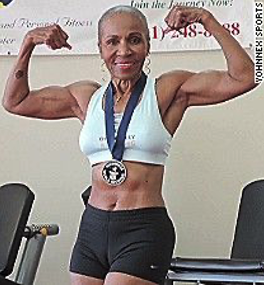Why Strength Work Needs to Be a Priority at Every Age
By: Nancy Palermo
“Every day is another chance to get stronger, to eat better, to live healthier, and to be the best version of you.”
In 2020 the Baltimore Sun did an article on an 84-year-old grandmother, mother, and retired secretary, Ernestine Shepherd, who won the Guinness World record for the oldest female competitive bodybuilder in the world.
This record won her the title of “6-pack Granny”

What makes Ernestine’s story so amazing is she did not start working toward this goal until her mid-50s after the death of her sister. Prior to that she rarely visited a gym. Ernestine’s story is a great reminder that it is never too late to get in shape, and you are never too old to build muscle.
There are many reasons we want to build muscle too. As we age, we can lose up to 3-4 % of our muscle mass every year. In fact, if we are not doing something to build muscle, the loss can begin in our 20s. So, this means you can lose up to 40% of your muscle mass between the ages of 20-80 if you are not doing something to fight it.
Losing muscle mass is associated with an increase in mortality.
One study looked at leg strength and grip strength in older adults and found with reduced grip strength and leg strength there was a 23% increase in mortality. Many individuals with less muscle strength are more likely to fall and suffer the long-term consequences of their injuries. In older adults, falls are synonymous with disability and declining health. Building muscle strength, especially with respect to stability and balance helps to reduce the risk of falls that can lead to fractures that disable.
In addition to the appeal of a muscular physique, adding muscle is also beneficial to our bones and posture. In fact, there is no drug that compares to the bone-building effects of strength work and muscle-building exercise. When we build muscle, our bones must adjust, and this is done through the stimulation of bone density. increasing bone density means you reduce the risk of developing osteoporosis later in life.
If everything discussed is not enough to motivate you to pump some iron, strength work is also associated with the management of blood sugar, body fat, and metabolism. Muscle burns 9 X’s more calories than other tissues in the body. It is considered energetically expensive to maintain. This is a good thing. Since muscle requires more energy in the form of glucose it can ramp up our metabolism. The muscle also has the ability to produce its own glucose from body fat through a process called gluconeogenesis. It can take fatty acids from body fat and produce the glucose it needs to fuel it. Therefore, higher muscle is associated with lower fasting insulin levels and lower blood sugar levels. This makes muscle building more than just a way to change your body composition, it is a way to change your overall health.
If strength work is not a part of your exercise regimen, consider slowly adding it.
Try to incorporate strength exercises that call on your biggest muscle groups, so you get more bang for your buck. Weighted exercises like power lifts, deadlifts, squats, and bench presses are great ways to build these larger muscle groups. Weighted balancing exercises can help to develop smaller muscles that help with stability. For example, lifting one leg while curling your biceps can help with balance and stability. If you want to get some aerobic benefits, try compound strength exercises. Compound exercises are working out the upper body and lower body with weights at the same time. This will help to bump up your heart rate while you lift. An example of compound exercises would be squats with overhead press or lunges with bicep curls.
Do not be afraid to increase the weights as this will stimulate the most muscle growth and maintenance with time. Often, we do use heavy enough weights and thus do not get the optimal muscle-building benefits. If you are new to strength, then start slowly and consider working out with a trainer or in a class where a trainer can support you in a safer environment. If you are looking for a safe and supported environment to safely build muscle, check out one of the strength classes at Thrive. These classes will meet you where you are with modifications based on ability.
Now it’s time to go pump some iron!!!



